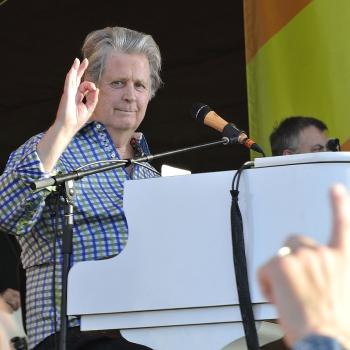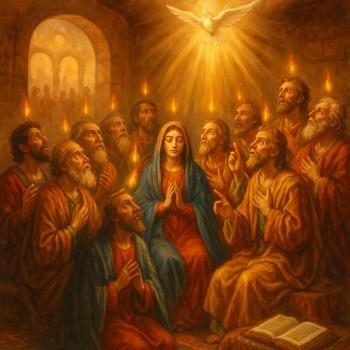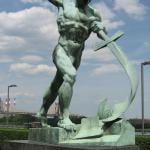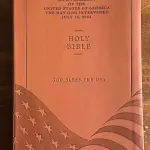The Adventurous Lectionary – The First Sunday in Lent – February 21, 2021
Bruce Epperly
Genesis 9:8-17
Psalm 25:1-10
I Peter 3:18-23
Mark 1:9-15
Lent is a time of spiritual decluttering and creative transformation. We prune the branches so that the light can shine through. We smash the idols that stand in the way of authentic worship and service. We let go what keeps us from experiencing God’s presence in our lives and awaken to God’s new possibilities for us and our communities. During Lent, we need to repent, turn around, and move from deathful behaviors to life-supporting actions and attitudes. We need to see ourselves for what we are personally and as a nation, and then turn toward justice, embodying God’s moral and spiritual arc in our daily and institutional lives.
Today’s readings can take a preacher and congregation in a variety of directions. We can reflect on mystical experiences, the activities of the Holy Spirit, the nature of temptation, God’s care for the non-human world, and the scope of salvation. We can also reflect on images of hope in a time of crisis. Perhaps, these apparently disparate topics are joined together by Jesus’ calling to share God’s good news. God’s good news is reflected in the rainbow, spiritual insights, the struggle for self-awareness, and second chances given to us even beyond the grave. God’s news is always hopeful, even if the “celestial surgeon,” must perform surgical procedures to extract what detracts from personal and corporate well-being.
While ambiguities are present in the passages from Genesis and Peter, both scriptures suggest that God’s aim is universal healing. Briefly put, these ambiguities involve the character of a god who destroys the world and its creatures, providing safety for a small community of humans and animals. In a fashion similar to Greek and Norse mythology, God’s destructive behavior, especially God’s destruction of children and morally upright adults, far exceeds a just punishment for finite sin. The scriptures emphasize that despite the reality of destruction, God makes a covenant with all creation, going beyond humankind to embrace the non-human world. Christ preaches to spirits imprisoned, who were lost in the great flood, and might have had the time to repent and change their ways. Christ identifies with human suffering, and through the cross provides a pathway to healing. God’s power and care are manifest in the non-human and post-mortem worlds alike.
While few of our congregants in mainline and progressive churches expect the destruction of the Earth through divine activity, we are aware of the precariousness of our global situation, politically, economically, and ecologically. In some places, the waters are rising and putting cities and farms at risk, Given the realities of climate change and the instability in our Capitol and across the globe, we are, to quote Martin Luther King, experiencing midnight in America. We know the ambiguity – and dare we say destructiveness – of our own actions. We need to hear and then respond to our self-destructive behaviors by sharing and acting on the good news we receive with great humility and recognition of our complicity in injustice and ecological destruction. Our good news, inspired by God’s images of hope amid threat, must go beyond self-interest to provide wholeness for humankind and non-creation in all its wondrous and threatened diversity. We need divine refreshment and spiritual insight to find our own way through the wilderness.
As usual, Mark is the master of brevity. Within a few short verses, we read of Jesus’ baptism, the descent of the Spirit, the retreat (or temptations) in the wilderness, and the startup of Jesus’ ministry. Such literary conciseness awakens the imagination of preacher and congregation alike. The imaginative reader is filled with questions about this brief reading in which four apparently separate events flow into one another in an organic way.
John baptizes Jesus, and that’s enough said, at least from Mark’s perspective. Yet, we wonder why Jesus needed to be baptized if he was God’s chosen messenger and savior. Of course, Mark doesn’t yet tell us of Jesus’ uniqueness as God’s Beloved Child and suggests that in some way the Holy Spirit touches Jesus, empowering him and singling him out, in the wake of his baptism. What does it mean for the Spirit to descend upon Jesus? Is this somehow physical, like the flight of dove? Or is Jesus filled with superabundance of divine energy, insight, and wisdom? Is Jesus’ self somehow transformed in such a way that power flows from him to change peoples’ lives, body, mind, spirit, and relationships? Is this the moment when Jesus fully discerns his vocation as God’s beloved son and healer of humankind? Or, has he been aware of his deepest identity as he matured from childhood to adulthood?
Mark suggests that concurrent with John’s baptism, Jesus has a mystical experience in which the heavens are opened and Jesus receives a vision of God’s inner life and vision for human life. He discovers his unique relationship with his Parent God.
Mysticism alone cannot guide our vocational path. Jesus needs to ground his mystical encounters in prayer, meditation, and fasting. Moreover, mysticism is completed in acts of compassion and social transformation. The same Spirit that enlivens also compels, and so Jesus is driven into the wilderness, where he is tempted by Satan. Our greatest gifts and aspirations can become harmful if they are not channeled through God’s wisdom and our own spiritual maturity. Dramatic as it was, spiritual insight and paranormal experience is not enough. Mark doesn’t tell us the ways Jesus was tempted, and perhaps that’s good news. His brevity and silence enables us to explore our own temptations, and the good things we dwell upon that keep us from what is best for us and others.
Jesus goes to the wilderness to be alone but soon finds himself in a crowd of unexpected companions. Wild beasts abound and so do angels. It is unclear whether these wild beasts are menacing or friendly. Could it be that the covenant with all creation, described in Genesis 9, is fulfilled as Jesus – like St. Francis – reaches out to Brother Wolf and Sister Snake? In any event, Jesus’ time of testing and temptation is not entirely solitary. Angels “wait” on Jesus. Spiritual powers support his journey. Could we be supported, unknown to us for the most part, by spiritual presences whose purpose is to guide us from falsehood to truth and self-interest to compassion? Are we in the presence of our “better angels,” to quote Lincoln, who call us to follow what is best in ourselves and humankind? Do angels guide our steps, and keep us from harmful actions at pivotal moments of our lives? Can we encounter spiritual help when we call upon angelic guidance? Are the angels that I Peter 3:18-23 describes also available to us through our baptisms and alignment with God’s vision? (For more on the angelic, see Bruce Epperly, “Angels, Mysteries, and Miracles: A Progressive Vision.”)
Jesus’ retreat in the wilderness ends, and he is lured from silence of the wilderness to the cacophony of human need. Contemplation is balanced by action. Introspection gives birth to outreach. Jesus goes public. So begins the public message of God’s good news to humankind. Once more, the imaginative pastor and congregant is invited to consider, “What is God’s good news? What’s the good news we share with others here in church? In what ways can we good news givers?”
Mark doesn’t give us an outline of Jesus’ message, but surely his good news involves the invitation to personal transformation, to see ourselves and others in new ways, to discern our relationship with God’s realm, and open to God’s healing and welcoming touch. We are to be citizens of a new realm, God’s realm on earth as it is in heaven. God makes a covenant with all creation and invites us to be companions in bringing good news to the human and non-human world. (For more on Mark’s Gospel, see Bruce Epperly, “Healing Marks: Spirituality and Healing in Mark’s Gospel” and “Mark’s Holy Adventure: Preaching Mark’s Gospel for Year B.”)
+++
Bruce Epperly is a Cape Cod pastor, professor, and writer. He is the author of over 60 books including, WALKING WITH FRANCIS OF ASSISI: FROM PRIVILEGE TO ACTIVISM; MYSTICS IN ACTION: 12 SAINTS FOR TODAY; 101 SOUL SEEDS FOR GRANDPARENTS WORKING FOR A BETTER WORLD; LOVE IN A TIME OF CRISIS AND PANDEMIC (volume 3 of his pandemic trilogy); and THE JUBILEE YEARS: EMBRACING CLERGY RETIREMENT.












